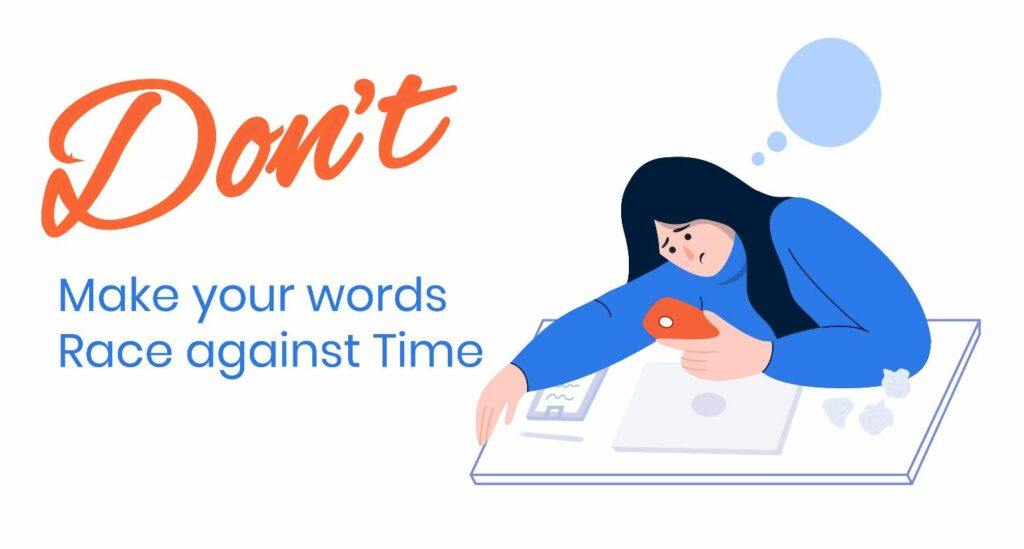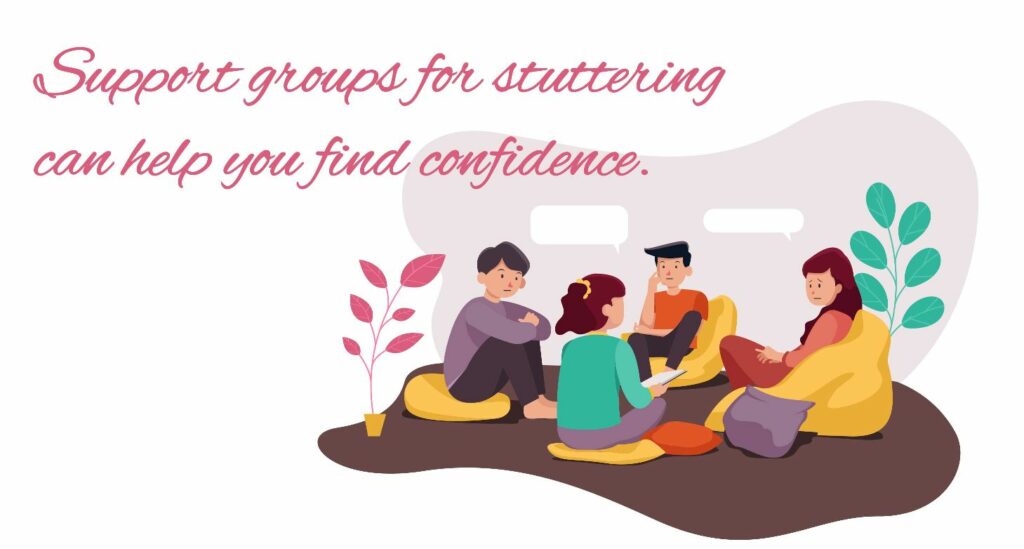A person who stutters can’t be efficient in communication. People who stutter (PWS) are nervous and need to relax. PWS cannot be great speakers.
We have heard so many infuriating comments ever since Biden’s “gaffes” went viral.
We have also received so much unsolicited stuttering advice from people with no experience of stuttering or speech-language pathology that it prompted us to create a do’s and don’ts list.
It has stuttering guidance for PWS, like us, who needs a boost of confidence right now.
You Stutter: So What Should You Do?
1. Take Your Time
When we anticipate a stutter, we often try to rush through what we have to say. We try to complete a whole sentence before we run out of breath.
Sadly, that doesn’t prevent repetitions, prolongations, or blocks. We put pressure on ourselves by setting a time limit on our speech.

Instead of rushing yourself, you could try to find a rhythm while talking. Sticking to a rhythm, speaking at a slow pace, and not putting pressure on yourself to finish a sentence in one breath will help you stutter less.
2. Use Frequent Pauses
Have you ever felt your stomach in knots? Because it’s not a question of if but when you are going to stutter.
That’s the anticipation of stuttering getting the better of you.
Several times a day, while speaking, we work ourselves up because we are afraid that we might stutter.
While it’s completely alright to stutter, we must remember to take a breather, literally.
Back in 2006, several researchers including Reitzes et al discussed pausing as a ‘rate control strategy’ while speaking.
Pausing can prepare you for an easy initiation.
Right when you anticipate a stutter, you can pause briefly, take a normal breath, and prepare to stutter differently.
Yes, it’s not avoiding a stutter. Or overcoming it. A short pause can give you a way to stutter differently.
3. Try Deep (Diaphragmatic) Breathing Techniques
The Starfish Project and McGuire Program both use diaphragmatic or costal breathing. It’s a physical speaking strategy that can help manage stuttering.
Normal or tidal breathing is an involuntary activity. ‘Costal breathing’ is breathing deeply.
You fill your lungs with air and empty your lungs before speaking.
When your lungs are full, the pressure on your vocal folds increases. That makes it more difficult to talk fluently.
You can try a simple experiment at home.
Try breathing in different volumes of air and try to begin talking with the different volumes in your lungs.
You will notice that talking with the maximum volume of air in your lungs is most difficult.
When the lungs contain between 30% and 60% of air (vital capacity), it’s much easier to begin speaking.
4. Notice The Listener’s Eye Color (Maintain Eye Contact)
Maintaining eye contact is not going to stop stutters. However, it will give you the confidence to express yourself despite your stutters.
Making direct eye-contact will help you overcome any shyness or feeling of self-doubt you have while talking.
Practice it for a couple of weeks. You will see that making and maintaining eye contact has become a natural habit while holding a conversation.
Noticing someone’s eye color is a quick-trick that will initially help you establish eye contact.
Try not to look away when you are stuttering or anticipating a stutter.
We break eye contact or look away during particularly stubborn blocks or prolongations because we feel embarrassed about how we might sound or look to our audience.
Well, you will be surprised to see how many people can look beyond how you sound, and care about what you have to say.
Just go ahead and try to establish eye contact while talking the next time.
5. Challenge Yourself to Step Out Of Your Comfort Zone A Little Every Day
When you have practiced costal breathing, strategic pausing, and maintaining eye contact for at least a month, it’s time to move to the next step – talking to strangers.
Yes, we do not like approaching or talking to people we don’t know.
We’d rather carry a list of items we need from the grocer and pay by card than ask or answer questions.
We’d rather wait for someone else to open the door than greet a visitor.
Phone calls make us break out in cold sweat and we wonder who doesn’t use texting in 2020!
That’s because we love the comfort bubble we have created for ourselves.
Make a list of tasks to challenge yourself, such as –
- Starting the conversation with 100 new people randomly (asking the time or talking about the weather, and introducing yourself as someone who stutters) on the streets or at the mall.
- Answer every time the phone rings. Tell the caller that you stutter and ask them to be patient with you.
- Going to shop at the local bodega or grocery store. Chatting up the grocer or cashier after disclosing your stutter and your goal of the week.
You will again be surprised to see how many people will remain empathetic and patient throughout your speech.
An account by Lon L. Emerick says that an exchange student almost got rid of her stutter after confronting almost 950 listeners in a week.
She was visibly tired and her voice was hoarse, but her stutter was almost gone!
6. Smile and Look Relaxed
Anxiety is contagious.
When you look tensed while talking, you risk making your listeners uncomfortable and tense as well.
You need to ensure that you look relaxed irrespective of the anxiety you are feeling. Although we don’t recommend it in every aspect, this is one place where we tell our readers to “fake it till you make it.”
Smiling more and looking relaxed will soon dissipate your anxiety little by little.
In a couple of weeks, you will feel genuinely relaxed. You will smile almost effortlessly while holding a face-to-face conversation.
7. Try Mindfulness and Yoga
Heather Kauffman says that yoga can modulate the autonomic nervous system activities.
Yoga or mindfulness won’t cure stuttering or reduce it directly. It will reduce anxiety and stress, which increases the frequency and intensity of stuttering.

Paul Brocklehurst, the Director of the Stammering Self-Empowerment Programme, England, first tried meditation when he was 21. Mindfulness meditation seemed easy to him because it didn’t require him to speak!
It turned his life around. Mindfulness meditation allowed him to be more fluent. He went back to school and got a degree in Speech therapy and a Ph.D. in Psycholinguistics.
A study from 2012 shows that meditation reduced the frequency of stuttering of the participants. It also reduced the impact of stuttering on a person’s life.
By keeping aside 20-minutes a day for mindfulness meditation or yoga, you too can make a difference in your life. Change the way YOU perceive your stutter. Only then you will be able to change the way you stutter.
8. Join Speech Therapy If Your Stuttering Is Severe
Speech therapy is an option for anyone whose stuttering is severe and it causes them to avoid certain situations.
Therapy can decrease avoidance behavior and increase self-confidence.
Stuttering therapy can be costly, irrespective of where you live. And it can be difficult to access during these trying times.
Nonetheless, therapy can help you find comfort in the way you speak. The goal if speech therapy isn’t always curing someone’s stutter.
In most cases, an experienced speech-language pathologist (SLP) or speech therapist will help you stutter confidently or find a new way to stutter.
You can find a list of certified and experienced speech-language pathologists in your area by running a search on Google. Verify the credentials of any therapist/SLP you choose with registered stuttering foundations or associations in your area.
9. Work With DAF Apps
When you are working with your SLP, you can talk about new technologies that can help your fluency.
Now, you can use your mobile phone to download and try Delayed Auditory Feedback (DAF).
It’s a technique that introduces a delay between speaking and auditory perception.
DAF allows anyone who stutters to speak normally by allowing them to hear their own voice a fraction of a second later. Not everyone experiences the same levels of fluency.
The effects of DAF can be temporary, but it has an immediate positive effect on the fluency of PWS without any impact on the naturalness of their speech.
10. Use Speech Therapy Apps
Many people either avoid going to speech therapy or discontinue after a few initial sessions because SLPs can be expensive. It is one of the leading reasons of high relapse rates among adults who stutter.
You can seek help from highly-rated speech therapy apps like Stamurai to complement your speech therapy. Or, you can begin your therapeutic journey with Stamurai’s speech exercises and fluency tools.
Using a speech therapy app regularly, whether alongside therapy or on its own, can help you find your rhythm and voice.
The state-of-the-art apps may use a combination of machine learning and AI to suggest new exercises apt for you. You can check your weekly and monthly progress.
Stamurai currently uses a guided training plan customized for each user.
The therapy protocol includes fluency shaping strategies and stuttering modification techniques.
11. Join Stuttering Support Groups
You are not alone!
Several nationally and internationally acclaimed stuttering associations have local chapters. Many of them have stuttering support groups.
The NSA (National Stuttering Association) in the United States, for instance, has over 200 local chapters for children, teens, and adults.

You can find independent, private, and open support groups online. You can search for communities for PWS and similar forums in your region or country.
Here at Stamurai, we have a dedicated Stuttering support Group for all users. PWS can join in on the scheduled group video calls. Each call is moderated and participants from across the world can join in.
What Should You Absolutely NOT do?
1. Worry about What Others Might Think
Life hasn’t been easy on us since we stammer. We have heard jibes, mean comments, mockery, and even faced bullying.
However, people are now becoming more aware of stuttering as a speech fluency disorder.
Today, there are more empathetic listeners than you can imagine.
We are not mind readers.
So, it’s only logical to give our listeners a chance even though we are afraid of impatience, and disrespect.
2. Hide Your Stammer
Whenever you need to talk to a new audience, let them know you stutter and that you are working on your speech.
Saying it upfront without making an effort to hide your stuttering can work wonders.
Politely request your listeners to be patient while you speak your mind.
Trying to hide your stutter will put undue pressure on you. It will increase your tendency to circumvent feared words and find replacements.
Anticipation can make upcoming blocks, repetitions, and prolongations much worse.
Disclosing your stutter, in the beginning, can feel like taking a weight off your shoulders. Do that and see how effortlessly you can stutter through what you have to say.
3. Speak Until You Are Ready To Speak
Costal breathing and pausing exercises will help you with your fluency. However, we have all experienced days when our stuttering is much worse.
On such days, if you want to keep to yourself and avoid group activities, it’s alright.
Fellow PWS and fluent speakers will understand your predicament. On such days, talking to your SLP or texting a friend about how you feel can help you.
4. Take Advice from People Who Aren’t Experts on Speech Fluency
“Slow down,” “take a deep breath,” “you are probably just tired” and “you need a good night’s sleep” are “advice” we have all received one time or another.
It has often made us think about how many of these advisors have dealt with stuttering. Or, how many have the qualification to dish out tips to those who stutter.
Many of these people don’t mean to condescend or criticize.
However, they don’t realize that these words do more harm than good.
It’s almost impossible to explain that to our listeners who don’t stutter.
So, the only way to deal with such advice is to say “thank you” with as much stuttering as possible accompanied by a broad grin!
Let’s Stutter Together, With Confidence and Pride
We hope that these do’s and don’ts help you in your journey.
We don’t believe stuttering to be a limitation. It’s simply a different way of talking.
So, if you stutter, do so with your head held up high. Remember to make eye contact and introduce yourself with a bright smile. Don’t hide your stutter.
You will find more friends than you have ever hoped for once you embrace your stutter and find your confidence.
Keep at the exercises, learn controlled breathing, try DAF with the help of your SLP, and use the Stamurai app to assist your fluency.










